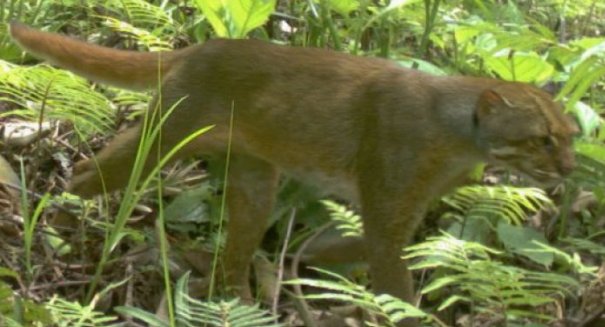
Camera traps are an excellent way for researchers to collect data on numerous species of mammals and birds.
The Zoological Society of London reports that the elusive bay cat has been captured on camera in its Borneo forest home. Prior to this achievement, the rare bay cat had been documented on camera traps just a few times in its home on the third largest island in the world. Now, more images of the bay cat have been snapped than ever before, along with proof of four other wild cat species in a heavily-logged area of forest where they were not forecasted to do well.
This is only one of four forest regions in all of Borneo which has so far been discovered to have all five species: the Sunda clouded leopard, leopard cat, flat-headed cat and marbled cat.
“We discovered that randomly placed cameras have a big influence on the species recorded,” noted Oliver Wearn, a researcher at ZSL and Imperial College London. “This is something I was taught in school – I remember doing a project on which plant species were most abundant on our playing field, and being taught to fling quadrats over my shoulder in a random direction before seeing what plants lay within it, rather than placing it somewhere that looked like a good place to put it – the same principle applies here.”
Camera traps are an excellent way for researchers to collect data on numerous species of mammals and birds, especially those that are well-versed in the art of seeing, and avoiding, researchers who try to find them. Camera traps work silently for many months, waiting to take photos of elusive species, like the bay cat.
“The cameras record multiple sightings, sometimes of species which we might be very lucky to see even after spending years in an area,” Wearn added. “For example, I’ve seen the clouded leopard just twice in three years of fieldwork, whilst my cameras recorded 14 video sequences of this enigmatic cat in just eight months.”
All five cat species are important parts of the forest ecosystem, as well as predators of a large range of other animals. Unfortunately, they are also “highly-threatened” species. For instance, four of the five species are listed as threatened with global extinction on the IUCN Red List. Researchers lack information on the habits of the bay cat, but it is thought to be at risk of extinction due to widespread loss of its habitat on Borneo.
However, the findings suggest that big carnivores, like the bay cats, can live in heavily-logged forests. The researchers hope to continue their study of the effects of logging on wildlife populations.
Leave a Reply